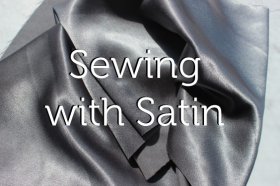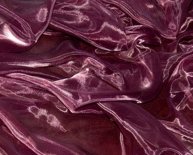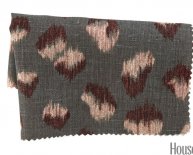
Patterned satin fabric
Satin is a beautiful, drapey fabric often used for formal wear. But it can be difficult to sew with because it is slippery and delicate. There are a few sewing satin tips to help you complete your sewing project with ease.

First Tip for Sewing with Satin: Storing
Store satin rolled up to avoid getting creases that need to be ironed out later. This is one of my favorite sewing satin tips because it’s really best to avoid ironing satin unless it is completely necessary. The heat from the iron can cause the fabric to glaze.
Cutting, Aligning & Marking
Use very sharp scissors. In fact, get your scissors sharpened before beginning a sewing project involving satin. Sharp scissors will and pulled threads that will ruin the look of your fabric.
Consider cutting your pattern pieces on the bias. This will alleviate some of the fraying issues that comes with sewing satin. However, be sure to give the fabric a rest before sewing to ensure that the fabric is not stretched out (which will result in fit issues later).
When laying out pattern pieces, whether on the bias or not, take care to have all of the pieces going the same way. Satin has a bit of a shine to it and the nap will be noticeable if the pieces are cut going in a different direction.
When marking pattern details like darts and arrows, use tailor’s chalk or an air-soluble pen. Satin is susceptible to water staining so you don’t want to mark with anything that requires water to remove. Always mark on the wrong side of your fabric and test on a scrap piece first.
Only pin in the seam allowance area to avoid holes in the actual garment.
Sewing & Pressing
Use a new, appropriately-sized sewing machine needle and good quality thread. Use a short stitch length and hold the fabric taut as you feed it through the machine. This will help prevent seam puckering. Cutting pattern pieces on the bias will also help with puckering.
It’s worth the time to hand-baste seams together, especially curved ones. Satin is very slippery and basting will keep everything where it needs to be while you feed it through the machine.
Be especially careful when pressing the garment. Avoid using the seam feature on your iron to prevent water staining. Always press from the wrong side. If you do need to press on the right side, use a pressing cloth. It’s also a good idea to place paper under seams when pressing them open to avoid creases on the right side of the fabric.
Finishing
Finishing your seams is a must because satin frays so easily. Pinking, serging and zig-zag stitching are all good options because they are lightweight and won’t show through on the right side of the garment.
Satin and seam-rippers do not get along. Ripping out a seam on satin is likely to cause holes. If you are unsure of the construction or fit of the garment you are making, it’s best to make a muslin first.
Sewing satin is certainly trickier than sewing less delicate fabrics, but with a little patience you’ll be just as pleased with the results. Let me know in the comments if you have any other sewing satin tips.

















